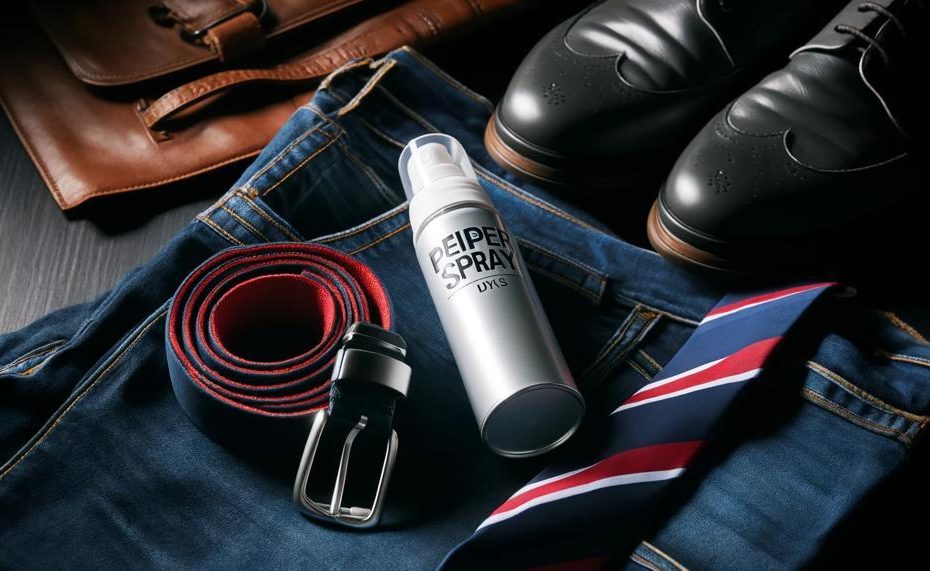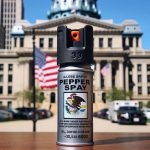To remove pepper spray from clothes, follow these steps:
- Remove contaminated clothing: Carefully take off the clothes that have been exposed to the pepper spray.
- Rinse with cold water: Rinse the affected area of the clothing with cold water to wash away as much of the pepper spray as possible.
- Apply a liquid detergent or dish soap: Apply a generous amount of liquid detergent or dish soap to the affected area.
- Rinse again with cold water: Rinse the clothing again with cold water to wash away the detergent or soap along with the pepper spray.
- Launder the clothing as usual: Wash the clothing in a washing machine as you normally would. If possible, air-dry the clothing to prevent heat from setting any remaining residue.
Before you start, it’s important to take some precautions:
Remember, pepper spray contains capsaicin, which can cause severe irritation and inflammation when it comes into contact with the skin, eyes, or clothing. Therefore, it’s crucial to handle contaminated clothing carefully to prevent further discomfort or damage. If the stain is stubborn, consider using a stain remover or pre-treatment.
Contents
Why Proper Disposal of Pepper Spray is Important
Pepper spray, a go-to for self-defense, packs a wallop in its small canister. But here’s the rub: if it’s tossed carelessly, it wreaks havoc. Let’s unpack why meticulous disposal is non-negotiable and the dire straits of turning a blind eye.
Impact of Proper Disposal
- Human Safety: The chemical brigade in pepper spray, mainly oleoresin capsicum (OC), is no small fry. Mishandling can lead to severe irritation, cough fits, and a whole shebang of respiratory blues. Safe disposal keeps these nasties at bay.
- Environmental Protection: Picture this: a canister chucked wrong, leaking into creeks and soil. It’s a surefire recipe for environmental grief, contaminating water and sending local critters on a nasty trip.
- Safeguarding Waste Handlers: Think about the folks who handle our trash. An errant canister becomes an occupational hazard, springing unwanted surprises on them.
Consequences of Poor Disposal
| Hazard | Description | Impact |
|---|---|---|
| Water Contamination | Pepper spray leaching into water sources | Disrupts aquatic life, renders water unsafe |
| Wildlife Distress | Animals exposed to discarded pepper spray | Health risks, altered behaviors |
| Human Risk | Injuries to unsuspecting individuals | Respiratory and skin irritation |
Safe Disposal Steps
- Emptying the Beast: Ensure the canister is out of juice. Do this in a well-ventilated space, and keep the kids and pets in another room.
- Disassemble with Care: Off with its head. Remove the actuator and cap, but mind your fingers and eyes.
- Check the Rule Book: Different strokes for different folks – or rather, areas. Your local regulations have the final say on how to bin it.
- Recycle or Bin It: If it’s recyclable, great. If not, it’s time for the bin, but not just any bin – follow those regulations.
Tips for Accidental Exposure on Clothing
Got some of the spicy stuff on your shirt? Don’t just scrub willy-nilly. Don gloves, hit a breezy spot, and gently blot and rinse. For the stubborn bits, stain removers and air drying are your friends. Avoid the temptation to scrub like mad or throw it in the dryer.
Safety Precautions Before Disposal
Before you bid adieu to your trusty pepper spray canister, it’s not just a toss-and-go affair. The concoction inside, chiefly oleoresin capsicum (OC), packs quite the punch, not just for the baddie it was meant for but also for Mother Nature and our furry friends.
| Safety Gear | Gloves, goggles | Protect yourself from accidental exposure. |
| Location | Outdoors/Well-ventilated area | Prevents inhaling harmful chemicals. |
| Keep Away | Children and pets | Avoid accidental exposure to vulnerable ones. |
| Read Instructions | Manufacturer’s guidelines | For specific disposal steps. |
| Local Regulations | Contact authorities | For legal and safe disposal methods. |
| Emptying | Outdoor or ventilated spot | Ensure canister is empty to prevent accidents. |
| Recycle/Trash | Based on local rules | Correctly categorize for disposal. |
Pepper spray, while a guardian in your pocket, demands a bit of respect and caution, even when you’re saying goodbye.
How to Dispose Pepper Spray Canisters

Disposing of pepper spray canisters must be done with care due to their combustible nature and the irritating effects of capsaicin. Here’s a guide on how to do it safely:
Assessing the Canister’s Condition
- Check if the canister is empty or still contains pepper spray.
- If it’s not empty, discharge it in a well-ventilated outdoor area, away from people and animals.
Preparing for Disposal
- Wear gloves to avoid direct skin contact with any residual pepper spray.
- Rinse the canister with water to remove any external residue.
Safe Disposal Options
| Method | Procedure | Notes |
|---|---|---|
| Trash Disposal | Place in a sealed bag and then in the trash | Not advisable for partially full canisters |
| Hazardous Waste Facility | Contact local facility for guidelines | Recommended for canisters with remaining spray |
| Recycling | Empty completely, remove cap, rinse and recycle | Check local recycling policies for aerosol canisters |
After Disposal
- Wash your hands thoroughly.
- Ensure you do not touch your face during the process.
Remember, safety first. If unsure about the disposal method, consult local waste management authorities for guidance.
Disposing of Expired or Unused Pepper Spray
Safely disposing of expired or unused pepper spray requires a methodical approach, ensuring personal safety and environmental care.
| Action | Details | Important Notes |
| Emptying | Aim away from face, depress actuator | Do outdoors in ventilated space |
| Disassembling | Remove actuator and cap | Wear gloves and goggles |
| Local Regulations | Consult local authorities | Varies by location |
| Disposal | Recycle or dispose as instructed | Avoid regular trash, toilets |
| Contaminated Clothing | Remove, isolate, wash separately | Use mild detergent |
Pepper spray, though a sterling self-defense ally, demands our respect in its disposal, ensuring we tread softly upon our shared environment. Let’s handle it with care, akin to the way we would treat any other potent tool.
Disposing of Pepper Spray on Clothing
Disposing of pepper spray from clothing ain’t a stroll in the park, but it’s doable with a bit of know-how and the right approach. Remember, that devilish concoction is potent and can give you a hard time even when you think it’s gone.
Here’s the lowdown on getting rid of it without causing a scene or hurting the planet.
| Step | Action | Reason |
| 1 | Don protective gear (gloves, mask) | To shield yourself from the pepper spray’s effects |
| 2 | Isolate the clothing | Prevents cross-contamination |
| 3 | Blot, don’t rub, the affected area | Minimises spread of the spray |
| 4 | Soak in a mix of cold water and baking soda | Neutralises the chemicals |
| 5 | Wash separately in hot water with detergent | Removes any lingering residue |
| 6 | Air dry outdoors if possible | Ensures no trace elements remain |
| 7 | Repeat if necessary | Some fabrics may hold residues longer |
Remember, if the garment’s a goner and there’s no saving it, you’ll want to consult your local waste management folk to see how to ditch it without doing a number on the environment. Each place has its quirks about what goes where, so a quick chat can save you from a heap of trouble.
Also, a word to the wise: time’s a thief with pepper spray on fabric. The longer it sits, the more it sticks. So, jump on it like it’s hot. Literally. And after you’ve dealt with the mess, give your hands a good scrub. Pepper spray’s clingy like that.
Disposing of Pepper Spray in an Emergency
The safest and most effective way to dispose of pepper spray in an emergency situation involves a few critical steps to ensure the safety of both individuals and the environment. Below, we outline a clear and direct method, adhering to local guidelines and prioritizing personal safety.
Immediate Actions
- Contact Local Authorities: Your first step should be to inform local authorities such as the police or hazardous materials (hazmat) teams. They can provide specific, safe disposal instructions and assistance.
- Secure the Area: Evacuate and secure the area to prevent exposure and ensure the safety of others.
- Prevent Contamination: Avoid disposing of the canister in regular trash or sewage systems to prevent environmental damage.
Detailed Disposal Steps
| Step | Action | Details |
| 1 | Empty the Canister | Release any remaining contents in an open, well-ventilated area to reduce pressure in the canister. |
| 2 | Remove Actuator and Cap | Disassemble the canister to prevent accidental discharge during disposal. |
| 3 | Check Local Regulations | Review local waste management policies to determine the correct disposal or recycling options. |
Handling Contaminated Clothing
- Isolate Clothing: Remove any clothing that has come into contact with pepper spray. Isolate these items in a plastic bag.
- Wash Separately: Launder contaminated clothing separately using a mild detergent to avoid spreading the irritant.
- Dispose of Gloves: Safely dispose of any gloves or protective gear used during the cleaning process to prevent secondary contact.
Conclusion
Getting pepper spray out of your clothes isn’t just a matter of cleaning up spots; it’s a mission to stop a dangerous enemy.
You can get your clothes out of its grips of this powerful self-defense tool if you know how to use it right. If you know how to properly get rid of pepper spray, you can keep your clothes from getting damaged, whether they are made of delicate silk or strong jeans.
Cold water and baking soda baths are a gentle but effective way to clean, or you can use special soaps for spots that are really stubborn. It’s important to keep in mind that merely addressing the issue is only half the battle. You also need to protect your skin and breath during the process.
From pollution to repair, the process needs time, care, and a bit of haste. Quick action is key to success—time is of the essence because pepper spray’s strong chemicals become more stubborn as time goes on.
You can complete the task if you carefully separate the damaged clothing, put on safety gear, and follow the given steps.





